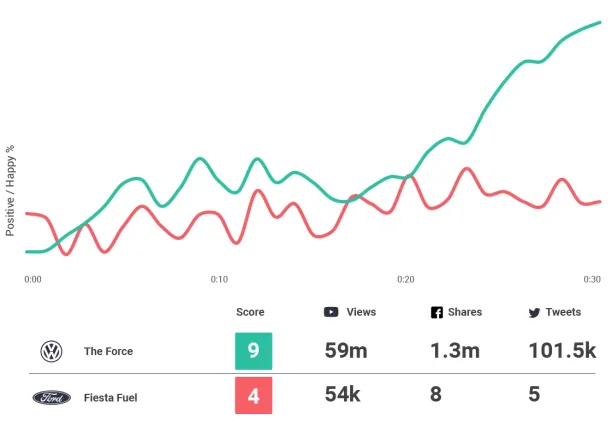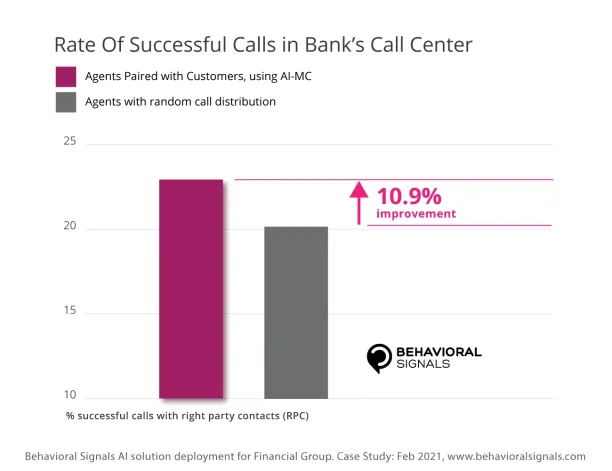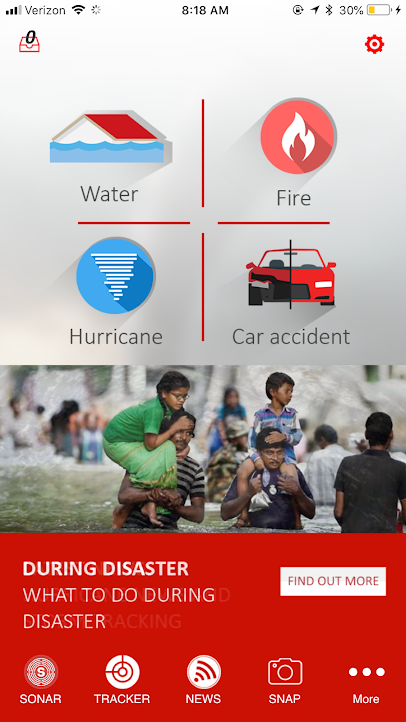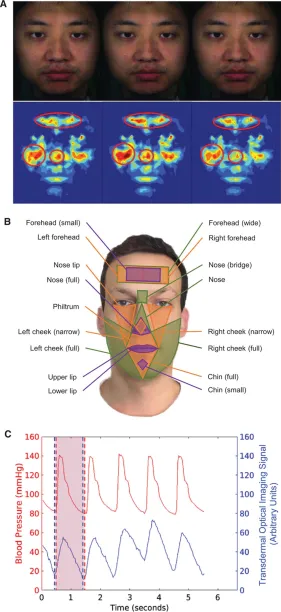Top 10 Emotional AI Examples & Use Cases in 2024
The emotion detection and recognition (EDR) market was valued at ~$38 in 2022, and is expected to grow around 17% annually until 2030. Emotion detection and recognition rely on emotion AI to identify, process, and simulate human feelings and emotions. And businesses have been leveraging emotion AI in numerous applications, ranging from customer service to recruiting.
In this article, we’ve compiled examples and success stories of businesses leveraging emotion AI in marketing, customer service, healthcare, education, and gaming.
Marketing
1. Brand exposure
Realeyes conducted a study on 130 car ads collected from social media platforms to understand what video features gain audience attention.
The study showed a correlation between high emotional performance and social media success. Ford Fiesta, a rational ad that is entirely product-oriented which scored lower on Realeyes emotion AI score than Volkswagen ‘The Force’ ad which employs narrative and humor. Thus, increasing brand exposure and social media interactions, and creating a positive association with the brand.

Source: Realeyes case study on automotive ads
2. Subway ads
Brazil’s Yellow Line of the Sao Paulo Metro deployed AdMobilize emotion AI analytics technology to optimize their subway interactive ads according to people’s emotions. AdMobilize emotion AI software is integrated into security cameras to measure face metrics, such as gender, age range, gaze through rate, attention span, emotion, and direction. These metrics enabled advertisers to classify people’s expressions into happiness, surprise, neutrality, and dissatisfaction, and change their ads accordingly.
3. Travel recommendation
Skyscanner, a metasearch engine and travel agency, deployed Sightcorp’s emotion AI technology to their Russian website. Sightcorp’s face analysis tool leverages emotion AI to anonymously detect and measure facial expressions like happiness, sadness, disgust, surprise, anger, and fear. Skyscanner used this technology to create an engaging experience with their customers as they book their flights such that a customer would take a picture of themselves and the API will process it, and display face results along with a targeted travel recommendation. For example, if a user displays “sad” emotions, the API would suggest a “fun” travel destination.
Customer service
4. Customer matching to the right agent
A European bank partnered with Behavioral Signals to maximize the effectiveness of its call center agents.
Behavior Signal’s technology leverages emotion AI and natural language processing to analyze the behavioral signals from user voices, reactions, word choice, and engagement. The bank deployed the AI-enabled agent-customer matching technology to route customer calls based on their previous calls recorded in their CRM profile data (e.g. non-performing loans (NPLs) historical data, and metadata on actual payments). The call success ratio improved ~11% when customers were matched with the right agent.

You can work with an AI data service to overcome the hassle of gathering AI training data. Check out the following articles:
- Top 12 AI Data Collection Services & Selection Criteria
- Data Crowdsourcing Platform: 10+ Companies & Criteria
Also, check our data-driven list of sentiment analysis services to determine which option satisfies your company’s needs.
5. AI-based agent coaching
MetLife, a US insurance corporation, implemented Cogito’s emotional AI coaching solution in 10 of its U.S. call centers to provide real-time guidance to agents while speaking to a customer. Cogito’s emotion AI technology leverages Signal-Based Machine Learning, a neural network model that enables incremental, real-time inferences on streamed signal data to understand emotional states and implications during a conversation, and provide real-time conversation tips and resolutions to agents. Deploying Cogito’s emotion AI coaching solution enabled MetLife to obtain:
- A higher NPS score by 14 points
- 5% improvement in “Perfect Call” scores
- 6.3% improvement in issue resolution
- 17% reduction in call handling time
Education
6. Tutoring program optimization
Vedantu, an Indian online tutoring platform, leveraged Entropik Tech emotion AI solution to optimize their educational content and strategy. Entropik’s emotion AI technology relies on eye tracking and facial coding algorithms to analyze emotional triggers and map user journeys. Student sessions were recorded and passed through the eye-tracking API to generate engagement, attention, and fatigue metrics for both students and tutors. Entropik claims that the metrics were 92% in correlation with existing ratings. These metrics enabled the tutoring platform to:
- identify areas of improvement in their content and presentation method
- increase students’ attention span
Healthcare
7. Covid-19 crisis monitoring
Cognovi Labs, an emotion AI analytics solution developer, created a Coronavirus Panic Index to track consumer sentiments and trends about the pandemic and spread of Covid-19. Cognovi’s solution relies on analyzing emotions from public data about the pandemic from social media, blogs, and forums, in order to predict how the population in a specific area will respond to certain pandemic-related events. These insights can be leveraged by businesses and government officials to develop virus-containment strategies, raise awareness about Covid-19, and provide physical and mental healthcare accordingly.
8. Disaster and emergency management
SONAR, a disaster and emergency communication decentralized application, leverages Kairos emotion AI solution to deliver medical help during the Caribbean hurricane. Kairo’s emotion AI solution can detect, identify, and verify faces, and understand the liveliness of a face. SONAR utilized Kairos such that during a disaster, a person will take a selfie which can be scanned, identified, and linked to their personally identifiable information (PII), and their medical condition can be detected at the time of taking the image. This information is then expedited to emergency management and medical agencies to provide help.

Source: SONAR dApp on Google Play store
9. Blood pressure detection
The American Heart Association developed an app using NuraLogix emotion AI algorithms to detect blood pressure levels from 2-minute videos. The algorithm extracts blood pressure features from:
- facial blood-flow signals (light near skin surface which reflects hemoglobin concentration
- physical characteristics (age, weight, skin tone)
The model was able to detect blood pressure with ~95% accuracy.

Gaming
10. Biofeedback gaming
Flying Mollusk, a game development studio, leveraged Affectiva‘s emotion AI technology to develop an adaptive psychological thriller video game “Nevermind“. The game deploys emotion AI to understand the gamer’s feelings from their webcams and adjust the game experience accordingly. For example, if a player exhibits stressful behavior, the game atmosphere may get darker and stressful situations may be displayed, such as a flooding room or a falling roof. Same way, when the player calms down, the game will project a calm atmosphere.
To explore emotion AI in detail, feel free to read our in-depth articles:
- What is Affective Computing / Emotion AI: In-depth Guide
- 24 Affective Computing (Emotion AI) Applications / Use Cases
You may also be interested in our sortable/filterable lists of:
And if you believe your business can benefit from emotion AI, get in touch with us to find you the right solution:

Cem has been the principal analyst at AIMultiple since 2017. AIMultiple informs hundreds of thousands of businesses (as per similarWeb) including 60% of Fortune 500 every month.
Cem's work has been cited by leading global publications including Business Insider, Forbes, Washington Post, global firms like Deloitte, HPE, NGOs like World Economic Forum and supranational organizations like European Commission. You can see more reputable companies and media that referenced AIMultiple.
Throughout his career, Cem served as a tech consultant, tech buyer and tech entrepreneur. He advised businesses on their enterprise software, automation, cloud, AI / ML and other technology related decisions at McKinsey & Company and Altman Solon for more than a decade. He also published a McKinsey report on digitalization.
He led technology strategy and procurement of a telco while reporting to the CEO. He has also led commercial growth of deep tech company Hypatos that reached a 7 digit annual recurring revenue and a 9 digit valuation from 0 within 2 years. Cem's work in Hypatos was covered by leading technology publications like TechCrunch and Business Insider.
Cem regularly speaks at international technology conferences. He graduated from Bogazici University as a computer engineer and holds an MBA from Columbia Business School.
To stay up-to-date on B2B tech & accelerate your enterprise:
Follow on
Comments
Your email address will not be published. All fields are required.